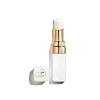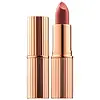Chanel Rogue Coco Baume Hydrating Beautifying Tinted Lip Balm Versus Charlotte Tilbury K.I.S.S.I.N.G Lipstick
What's inside
What's inside
 Key Ingredients
Key Ingredients

 Benefits
Benefits

 Concerns
Concerns

 Ingredients Side-by-side
Ingredients Side-by-side

Octyldodecanol
EmollientPentaerythrityl Adipate/Caprate/Caprylate/Heptanoate
EmollientHydrogenated Polyisobutene
EmollientSynthetic Wax
AbrasivePolyglyceryl-10 Decaisostearate
EmollientSqualane
EmollientPolyglyceryl-2 Triisostearate
EmulsifyingEthylene/Propylene Copolymer
AbrasiveDisteardimonium Hectorite
StabilisingButyrospermum Parkii Butter
Skin ConditioningOlea Europaea Fruit Oil
MaskingOlea Europaea Leaf Extract
PerfumingEthylhexyl Palmitate
EmollientCalcium Aluminum Borosilicate
Propylene Carbonate
SolventTribehenin
EmollientHydrogenated Castor Oil
EmollientTocopherol
AntioxidantJojoba Esters
EmollientSilica
AbrasiveHelianthus Annuus Seed Wax
Skin ConditioningParfum
MaskingSorbitan Isostearate
EmulsifyingLactic Acid
BufferingPolyglycerin-3
HumectantAcacia Decurrens Flower Wax
EmollientTin Oxide
AbrasivePalmitoyl Tripeptide-1
Skin ConditioningWater
Skin ConditioningCI 12085
Cosmetic ColorantCI 15850
Cosmetic ColorantCI 15985
Cosmetic ColorantCI 17200
Cosmetic ColorantCI 19140
Cosmetic ColorantCI 42090
Cosmetic ColorantCI 45380
Cosmetic ColorantCI 45410
Cosmetic ColorantCI 73360
Cosmetic ColorantCI 77163
Cosmetic ColorantCI 77491
Cosmetic ColorantCI 77492
Cosmetic ColorantCI 77499
Cosmetic ColorantCI 77742
Cosmetic ColorantCI 77891
Cosmetic ColorantMica
Cosmetic ColorantOctyldodecanol, Pentaerythrityl Adipate/Caprate/Caprylate/Heptanoate, Hydrogenated Polyisobutene, Synthetic Wax, Polyglyceryl-10 Decaisostearate, Squalane, Polyglyceryl-2 Triisostearate, Ethylene/Propylene Copolymer, Disteardimonium Hectorite, Butyrospermum Parkii Butter, Olea Europaea Fruit Oil, Olea Europaea Leaf Extract, Ethylhexyl Palmitate, Calcium Aluminum Borosilicate, Propylene Carbonate, Tribehenin, Hydrogenated Castor Oil, Tocopherol, Jojoba Esters, Silica, Helianthus Annuus Seed Wax, Parfum, Sorbitan Isostearate, Lactic Acid, Polyglycerin-3, Acacia Decurrens Flower Wax, Tin Oxide, Palmitoyl Tripeptide-1, Water, CI 12085, CI 15850, CI 15985, CI 17200, CI 19140, CI 42090, CI 45380, CI 45410, CI 73360, CI 77163, CI 77491, CI 77492, CI 77499, CI 77742, CI 77891, Mica
Octyldodecanol
EmollientPolybutene
Pentaerythrityl Tetraisostearate
EmollientEthylene/Propylene Copolymer
AbrasiveCaprylic/Capric Triglyceride
MaskingVp/Hexadecene Copolymer
Diisostearyl Malate
EmollientDicalcium Phosphate
AbrasiveSilica
AbrasiveHydrogenated Styrene/Methylstyrene/Indene Copolymer
Mica
Cosmetic ColorantOzokerite
Emulsion StabilisingStearalkonium Bentonite
Gel FormingPropylene Carbonate
SolventPentaerythrityl Tetra-Di-T-Butyl Hydroxyhydrocinnamate
AntioxidantCrambe Abyssinica Seed Oil
Skin ConditioningEthyl Vanillin
MaskingBixa Orellana Seed Extract
MaskingTin Oxide
AbrasiveCI 77891
Cosmetic ColorantIron Oxides
CI 15850
Cosmetic ColorantCI 45410
Cosmetic ColorantCI 73360
Cosmetic ColorantCI 19140
Cosmetic ColorantCI 15985
Cosmetic ColorantCI 42090
Cosmetic ColorantOctyldodecanol, Polybutene, Pentaerythrityl Tetraisostearate, Ethylene/Propylene Copolymer, Caprylic/Capric Triglyceride, Vp/Hexadecene Copolymer, Diisostearyl Malate, Dicalcium Phosphate, Silica, Hydrogenated Styrene/Methylstyrene/Indene Copolymer, Mica, Ozokerite, Stearalkonium Bentonite, Propylene Carbonate, Pentaerythrityl Tetra-Di-T-Butyl Hydroxyhydrocinnamate, Crambe Abyssinica Seed Oil, Ethyl Vanillin, Bixa Orellana Seed Extract, Tin Oxide, CI 77891, Iron Oxides, CI 15850, CI 45410, CI 73360, CI 19140, CI 15985, CI 42090
 Reviews
Reviews

Ingredients Explained
These ingredients are found in both products.
Ingredients higher up in an ingredient list are typically present in a larger amount.
Ci 15850 is the pigment color red. It is an azo dye and created synthetically.
Azo dyes need to be thoroughly purified before use. This allows them to be more stable and longer-lasting.
This ingredient is common in foundations, lipsticks, and blushes. This color is described as brown/orangey red.
It has many secondary names such as Red 6 and Red 7. According to a manufacturer, Red 6 usually contains aluminum.
Learn more about CI 15850Ci 15985 is a dye made from petroleum. It is synthetically created and approved by the FDA for use in foods and cosmetics.
The color of this dye is orange/yellow.
This ingredient can be found in makeup, sun care, and skincare.
Learn more about CI 15985CI 19140 is also known as Tartrazine. Tartrazine is a synthetic dye used in cosmetics, foods, and medicine to add a yellow color.
Tartrazine is created from petroleum and is water-soluble.
Some people may experience allergies from this dye, especially asthmatics and those with an aspirin intolerance.
Learn more about CI 19140Ci 42090 is a synthetic dye created from petroleum. It is used to give a bright blue color to cosmetics, medicine, and food.
CI 45410 is a synthetic red-pigment and dye.
It often goes by both Red 28 or Red 27; manufacturers label both ingredients as CI 45410.
This dye is commonly found in makeup because it imparts a vivid color. Some types of this dye change color based on pH level and interaction with moisture:
Your skin has a natural pH of around 4.5 - 5.5.
According to the FDA, CI 45410 is not permitted for use in eye products.
Red 27 is a flourescein dye and commonly used as a fluorescent tracer in medicine.
Learn more about CI 45410Ci 73360 is a synthetic red-pink dye.
Ci 77891 is a white pigment from Titanium dioxide. It is naturally found in minerals such as rutile and ilmenite.
It's main function is to add a white color to cosmetics. It can also be mixed with other colors to create different shades.
Ci 77891 is commonly found in sunscreens due to its ability to block UV rays.
Learn more about CI 77891Ethylene/Propylene Copolymer is an exfoliant.
Mica is a naturally occurring mineral used to add shimmer and color in cosmetics. It can also help improve the texture of a product or give it an opaque, white/silver color.
Serecite is the name for very fine but ragged grains of mica.
This ingredient is often coated with metal oxides like titanium dioxide. Trace amounts of heavy metals may be found in mica, but these metals are not harmful in our personal products.
Mica has been used since prehistoric times throughout the world. Ancient Egyptian, Indian, Greek, Roman, Aztec, and Chinese civilizations have used mica.
Learn more about MicaOctyldodecanol is a fatty alcohol. It is primarily used to enhance the texture of products.
As an emulsifier, Octyldodecanol helps prevent the oils and waters from separating. It also prevents ingredients from creating foam when shaken.
Octyldodecanol is created by reducing fatty acid to an alcohol.
Due to its high molecular weight, it does not get absorbed into the skin.
Learn more about OctyldodecanolThis ingredient is a solvent. It helps dissolve active ingredients and alter the texture of products.
Propylene Carbonate is commonly used in makeup and with clay, such as montmorillonite or bentonite.
Studies show this ingredient to be safe for cosmetics. When it is undiluted, it can cause skin irritation. (It is always diluted in skincare and makeup). This ingredient is water-soluble.
Propylene Carbonate is created from propylene glycol and carbonic acid.
Learn more about Propylene CarbonateSilica, also known as silicon dioxide, is a naturally occurring mineral. It is used as a fine, spherical, and porous powder in cosmetics.
Though it has exfoliant properties, the function of silica varies depending on the product.
The unique structure of silica enhances the spreadability and adds smoothness, making it a great texture enhancer.
It is also used as an active carrier, emulsifier, and mattifier due to its ability to absorb excess oil.
In some products, tiny microneedles called spicules are made from silica or hydrolyzed sponge. When you rub them in, they lightly polish away dead skin layers and enhance the penetration of active ingredients.
Learn more about SilicaTin Oxide is an inorganic oxide used to add opacity and volume to a product. In nature, it is already found in mineral form. The main ore of tin is an opaque and shiny mineral called casseterite.
Tin Oxide helps remove translucency in a product, or make it more opaque. Besides adding opacity, tin oxide is used for bulking to add volume.